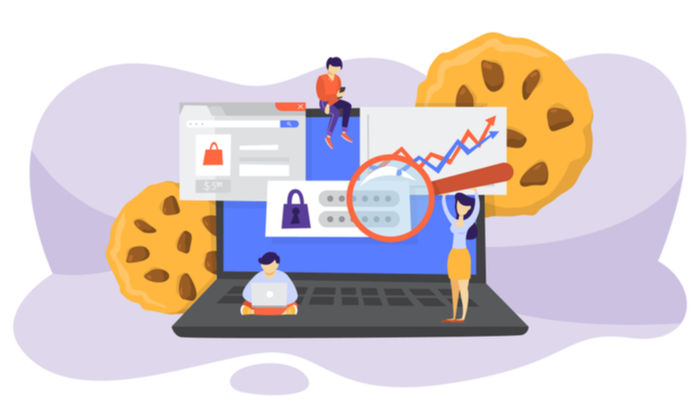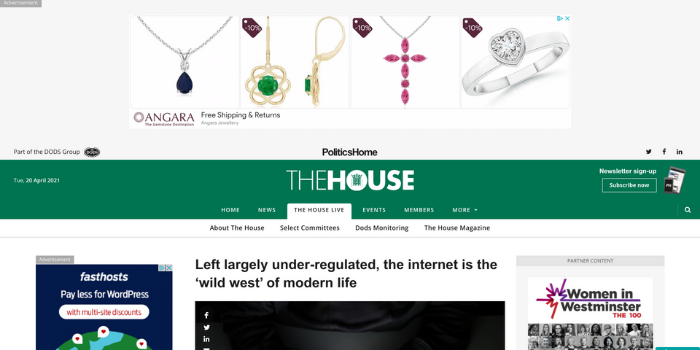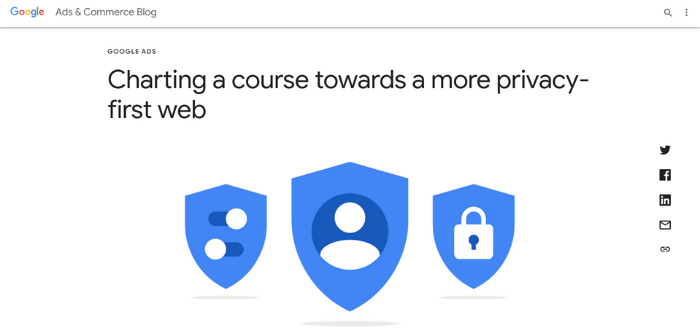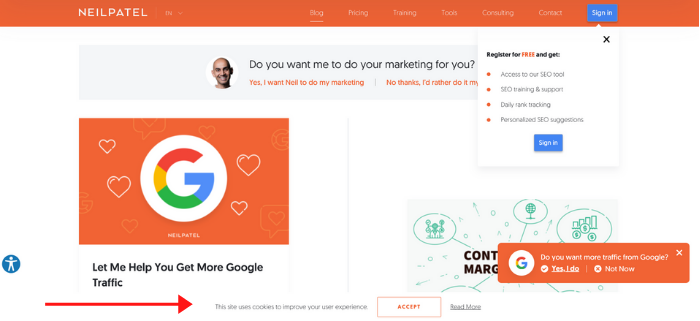
We’re all accustomed to ads following us around the internet. Is it a little creepy? It can be, but many people write it off as a part of using the web.
However, the world is changing. With a greater emphasis on privacy, the way personalized ads follow you around the internet could be, too. The big fish in the middle of all this Google, announcing in 2020 that by 2022, it would end the use of third-party cookies (what advertisers use to track you) on its browser, Chrome.
Ads are a fundamental part of how the internet works, so the quest to find a new way to provide users with personalized ads began and Unified ID 2.0 has established itself as a front runner.
What Is Unified ID 2.0?
Unified ID 2.0 is a proposed replacement for cookie tracking on the internet. It aims to add an extra layer to consumer privacy while facilitating personalized ads across the internet.
Essentially, we’re talking about how companies track your data, and as you can imagine, this is a complicated issue.
To understand Unified ID 2.0, it’s best to tell the story from the beginning, and look at how the concept came to be.
What Are Cookies?
To understand Unified ID 2.0, you’ve got to first understand cookies.
When you visit a website, it installs a small piece of code called a cookie in your web browser. This allows the website to recognize you the next time you visit, helping it to personalize your experience by, for example, automatically logging you into your account.
It is called a first-party cookie, and it seems like a useful tool, right?
There are definitely benefits to cookies, but there are also elements people are less thrilled about.
When you visit a website, you’re also likely collecting third-party cookies in your browser. As the name suggests, these are from a third-party company, normally an advertiser. These cookies can track you across the internet, learning about your habits, and allowing the advertiser to target you with more relevant ads.
Again, there are some benefits to this, but it’s also bringing up privacy concerns.
Questions About Privacy
Cookies are nothing new; they’ve been a common feature on the internet since 1994. However, the world has changed a great deal in that time (especially the way we interact with the internet), and privacy has become a major concern.
The way we interact with the internet has evolved so quickly that regulation has struggled to keep up. Governments are working to implement restrictions to keep people safe on the internet, and the same goes for the big tech companies.
Huge companies like Google, Microsoft, and Facebook now hold huge power over the way we engage with information, but with that comes a lot of responsibility. Consumers are becoming more aware of issues such as privacy, and they’re expecting these businesses to make changes.
Why Did We Need Cookies in the First Place?
Websites aim to offer value to their users. In the earlier days of the internet, though, they had no way of gauging what that audience looked like and how they interacted with the site.
This information is vital to provide users with high-quality, valuable information, so they started collecting that data. It also allowed advertisers to understand who site visitors are and what else they do on the internet.
The third-party cookies on your browser allow advertisers to paint a picture of your consumer habits and target you with more relevant ads. This is why when you browse the internet, the ads you see tend to be quite accurate to your wants and needs.
For example, you look for a necklace for your loved one once, and the image below shows you what follows you around the internet for the coming weeks and months.

On the more sinister side, this allows third parties to track your browsing, which naturally impacts your privacy. However, it also allows publishers to monetize their websites to fund the high-quality content you enjoy consuming.
Clearly, a balance must be found, and Unified ID 2.0 is one proposed solution.
Google’s Big Announcement: The End of Third-Party Cookies
Privacy and cookies have been talked about for a long time. However, perhaps happy with the status quo, publishers and advertisers weren’t necessarily braced for big changes.
That was until Google’s big announcement in 2020 that in 2022 it would start to stop companies tracking users across the web through its browser Chrome.

When a company as big as Google talks, people listen, and this immediately attracted advertisers and publishers’ attention. Chrome has cornered 69.28 percent of the internet browser market share, so this meant cookies would be changing for a huge number of users worldwide.
With uncertainty around what would replace cookies, and how advertising would work on the platform going forward, different proposals have been forwarded, and Unified ID 2.0 is one of the leaders.
Keeping the Internet Free
The changes in Google’s policy should offer greater levels of privacy for consumers, so where’s the catch?
One problem with these changes is that we view the internet as a free resource. We have instant, free access to any information we could ever want. However, it costs publishers money to create those resources.
Many publishers rely on ad revenues to fund the high-value information they provide consumers for free. If ad yields drop significantly as we move away from cookies, sites may have to change their business structure, potentially limiting the amount of free information on the internet (Some sites, like this one, use a different model and won’t be impacted. I don’t rely on ads to drive revenue, but many publishers do).
This means what follows cookies is an important decision that affects many people. Driven by some big names in the advertising industry, Unified ID 2.0 is one proposal that might strike the balance between privacy while preserving the value exchange.
What’s the Difference Between Unified ID 2.0 and Cookies?
Cookies are useful but clearly lacking when it comes to privacy, so how does Unified ID 2.0 change this?
Unified ID 2.0 is seen as the next progression in cookies. It collects the information advertisers need, but it puts the user at the heart of the decision-making process. Rather than using third-party cookies to track a user, websites use the user’s anonymized email address to identify when they log in.
It might sound like cookies in all but name, but it aims to improve them in three important ways:
- Anonymization: With Unified ID 2.0, your identity is anonymized using a unique identifier that cannot be traced back to your email or any form of ID. Your data is not traced back to you specifically; it’s traced back to your anonymized identifier.
- Control over privacy: New legislation has given users slightly more control over their privacy in recent years. When you browse the internet, you notice a lot more websites asking you for consent to track cookies. Constantly managing your preferences for every website you visit is a hassle, though. Unified ID 2.0 allows you to control your options from one single login.
- Transparency: One aspect that the creators of Unified ID 2.0 emphasize is explaining the value of tracking. The new platform aims to give consumers more information and show the relationship between tracking and the content they consume on the free web. It’s not like with cookies where we’re just expected to accept it; you’re given the information to make an informed decision.

One of the challenges for Unified ID 2.0 will likely be adoption rates.
Whereas cookies were almost universal, the success of Unified ID 2.0 relies on advertisers, publishers, and consumers all getting on board.
Why Is Unified ID 2.0 Replacing Cookies?
One of the issues with cookies is they can track users without their consent. Privacy has become a big issue in recent years, and governments are taking note.
In 2018, the European Union introduced the General Data Protection Regulation, which outlines rules for how data could be collected. This had repercussions for advertisers and publishers all over the world.
This kind of intervention was bound to grab Google’s attention, and by changing the way Chrome uses cookies, it’s responding to public and governmental concerns about privacy.
It comes down to a simple question: how do you feel about businesses tracking your every move around the internet?
For most people, it makes them feel uncomfortable (Mozilla, which has already blocked third-party cookies on its browser blocks over 10 billion trackers a day), even if it might result in a better experience.
Unified ID 2.0 could allow people to take control of the balance themselves. Using a unified email login, they can control their preferences, tailoring their settings to how they want to engage with the internet.
Rather than having cookies forced upon them, or having to set their preferences for every site they visit, Unified ID 2.0 will allow consumers to set their privacy preferences through a centralized login.
Essentially, it should put the decisions in the consumers’ hands.
The Effects of Unified ID 2.0 on Ad Personalization
Nobody loves seeing ads. Incorporating advertising into your content is an art, and there are plenty of websites that fail to do this, diminishing the user experience and rendering them almost unreadable.
However, what’s worse than seeing too many ads, is seeing ads that have absolutely no relevance.
The abolition of third-party cookies threatens to impact ad personalization in a big way, and this could have negative consequences for everyone involved. Users will see less relevant ads, reducing the user experience, and publishers will earn less revenue, forcing them to consider alternative forms of funding their content productions.
Unified ID 2.0 is a collaboration between big advertising companies that are working to blend privacy with existing levels of ad personalization. Ads are only useful if you get them in front of the right people, so these companies are working hard to find new ways of continuing to provide personalized ads to consumers.
Without third-party cookies, this might look quite different, but it’s in everyone’s interests to find a method that works. This might take some time to perfect, and Google will have a big say in what eventually replaces third-party cookies, but Unified ID 2.0 is certainly one of the leading options.
Conclusion
The end of third-party cookies was driven by the public’s wish for greater privacy, which is becoming a growing concern. Google isn’t the first company to get rid of third-party cookies, but with such a huge share of the market, it will have a wide-reaching impact on digital marketing.
Personalized ads are a huge part of how the internet works, allowing publishers to fund the high-value content they offer for free. If changes to third-party cookies mean ad personalization is no longer effective, this could have long-reaching impacts.
Unified ID 2.0 is one proposal that aims to strike a balance between improved privacy for consumers while keeping ads as a valuable revenue source for publishers.
It remains to be seen what comes after cookies, but the results could make the internet look very different. If you want help navigating digital marketing in the age of privacy, let our agency know. Our team of experts is here to help!
What are your thoughts on Unified ID 2.0?
from Blog – Neil Patel https://ift.tt/3sT07yW
via IFTTT
No comments:
Post a Comment